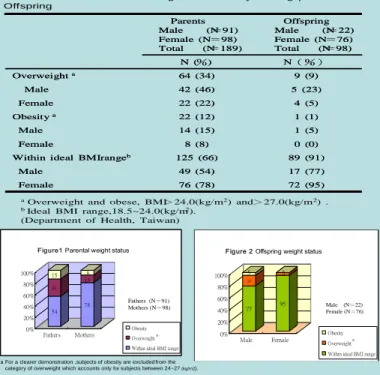The related study of anthropometric status
between university students and their parents
Yan-Han Yu , Shu-Hui Yang
School of Nutrition and Health Sciences,Taipei Medical University
*
Introduction
Materials and methods
Results and discussion
The global epidemic of overweight and obesity -"globesity“ –is rapidly becoming a major public health problem and further, the new burden in many parts of the world. World Health Organization (WHO)’s previous data release ind-icates that in 2005 more than 1 billion adults were overwe-ight globally,and at least 300 million of them obese. In the dimension of disease prevention, overweight and obesity are of the top awareness for they pose a major risk for chronic diseases, including typ-2 diabetes, cardiovascular diseases,hypertension,stroke,and certain forms of cancers. Recently, there have been concerns about overnutrition in Asian population as several studies manifest a higher risk for obesity-induced complications at lower body mass index (BMI) than western counterparts.Individual psycho-physical consequences,together with the high socio-economic costs of obesity and overweight suggest that serious interventions should be taken into consideration for better public welfare. Global upsurge in overweight and obesity is now confirmed to be attributable to the synergistic effect of exogenous and endogenous factors. The dramatic shift in diet pattern and trend towards sedentary life style take place while genetic predisposition lies underneath.
The purpose of this study is to confirm the idea of obesig-enic predisposition and assess the possible relationship between parental BMI and the BMI status of their offspring when other exogenous factors are excluded.
Subject characteristics
A total sample of 98 subjects were recruited from junior co-llege students, aged 20 ~22 yrs, in the School of Nutrition and Health Sciences at Taipei Medical University in March, 2007.
Anthropometric data
The BMI of the students and their parents was calculated from self-reported weight and height. BMI cut-off points for being overweight and obese are>24( kg/m2)and>27(kg/m2)
respectively, according to the BMI standard reference for adult set by Department of Health, Executive Yuan, R.O.C. Statistical analysis
The prevalence of overweight and obesity was calculated and the relative risk was used to describe the association of offspring overweight between different parental overweight status and referred to acceptable parental weight as the reference category.
Table 1 Prevalence of overweight and obesity among parents and
Offspring 72 (95) 76 (78) Female 17 (77) 49 (54) Male 89 (91) 125 (66)
Within ideal BMIrangeb
0 (0) 8 (8) Female 1 (5) 14 (15) Male 1 (1) 22 (12) Obesitya 4 (5) 22 (22) Female 5 (23) 42 (46) Male 9 (9) 64 (34) Overweighta N(%) N (%) Offspring Male (N=22) Female (N=76) Total (N=98) Parents Male (N=91) Female (N=98) Total (N=189) 72 (95) 76 (78) Female 17 (77) 49 (54) Male 89 (91) 125 (66)
Within ideal BMIrangeb
0 (0) 8 (8) Female 1 (5) 14 (15) Male 1 (1) 22 (12) Obesitya 4 (5) 22 (22) Female 5 (23) 42 (46) Male 9 (9) 64 (34) Overweighta N(%) N (%) Offspring Male (N=22) Female (N=76) Total (N=98) Parents Male (N=91) Female (N=98) Total (N=189)
aOverweight and obese, BMI>24.0(kg/m2) and>27.0(kg/m2) .
bIdeal BMI range,18.5~24.0(kg/m2).
(Department of Health, Taiwan)
Relative risk of offspring overweight
Table 2 shows the risk of offspring overweight according to different parental overweight status relative to the risk that both parents are of acceptable weight. The relative risk for having an overweight offspring was 5 times higher with both parental overweight than either parental over-weight. Data also demonstrated that the relative risk of offspring overweight in overweight mothers had a twofold increase compared with paternal overweight. This finding might be pointed to a possible difference of gender dispa-rity on obesigenic predisposition.
54 31 15 78 148 0% 20% 40% 60% 80% 100% Fathers Mothers
Figure1 Parental weight status
Obesity Overweight Within ideal BMI range Fathers (N=91) Mothers (N=98)
a
a For a clearer demonstration ,subjects of obesity are excluded from the category of overweight which accounts only for subjects between 24~27(kg/m2).
Weight status of subjects
The ratios for being within ideal BMI range shown in table 1 demonstrated that the female subjects in both popula-tions were more likely to stay in normal weight status than their male counterparts and the idea of gender discrepan-cy in prevalence of overweight at young and middle age might be suggested. 77 18 5 95 5 0% 20% 40% 60% 80% 100% Male Female
Figure 2 Offspring weight status
Obesity Overweight Within ideal BMI range Male (N=22) Female (N=76)
a
Table 2 Relative risk of offspring overweightaaccording to parental weight status
19.6 42
5/12 Both parental overweight
12.8 27 6/22 Maternal overweight 7.8 17 7/42 Paternal overweight 3.6 8 3/39 Either parental overweight
2 1/47
Both parents are of acceptable weightb
% N
Relative risk No. subjects overweight/ total
19.6 42
5/12 Both parental overweight
12.8 27 6/22 Maternal overweight 7.8 17 7/42 Paternal overweight 3.6 8 3/39 Either parental overweight
2 1/47
Both parents are of acceptable weightb
% N
Relative risk No. subjects overweight/ total
aOverweight, BMI>24.0(kg/m2) .
bWithin the ideal BMI range,18.5~24.0(kg/m2). (Department of Health, Taiwan)
Conclusion
The finding of this study highlights the idea of obesigenic predisposition and suggests that overweight parents are more likely to have overweight offspring than parents of acceptable weight. But for a more objective dimension of parental BMI status it’s important to know that parental effect contributes partly to genetic components, while se-veral other environmental factors, such as the lifestyle and diet patterns of the family, parental food preferences and attitudes, and the behaviors of parents and siblings should be lumped together to draw a comprehensive eff-ect. Due to the limitation of comprehensive data collectin-g, further study is required to explore the whole picture of parental BMI effect.
